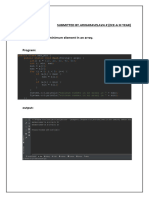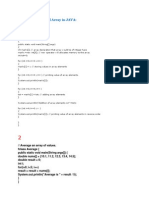0 ratings0% found this document useful (0 votes)
21 viewsBlock Swap Algorithm
Uploaded by
Dixxy ScottCopyright
© © All Rights Reserved
We take content rights seriously. If you suspect this is your content, claim it here.
Available Formats
Download as TXT, PDF, TXT or read online on Scribd
0 ratings0% found this document useful (0 votes)
21 viewsBlock Swap Algorithm
Uploaded by
Dixxy ScottCopyright
© © All Rights Reserved
We take content rights seriously. If you suspect this is your content, claim it here.
Available Formats
Download as TXT, PDF, TXT or read online on Scribd
You are on page 1/ 1
~Block swap algorithm~
Also known as array rotation.
Operates by dividing the array into two blocks and then swapping the elements
between these blocks in a specific manner.
TIME COMPLEXITY = O(n)
The rotation is by 'd' elements.
The two blocks are 'd' and 'n - d'
Base condition -> d == 0 or d == n
APPLICATION:
-> Data shifting: To shift data cyclically such as elements in buffer array or
shift cyclic operations.
-> Memory Management: Can be used to optimize in place array rotation without using
extra memory.
-> Circular buffers: manage data movement in cyclic buffers.
CODE:
class BlockSwap{
static int[] swap(int[] arr, int k, int n){
if(k == 0 | k == n){
return arr;
}
if(k > n){
k %= n;
}
int[] result = new int[n];
for(int i = 0; i < n; i++){
result[i] = arr[(i + k)%n];
//for right rotate (n - k + 1)
}
return result;
}
public static void printArray(int[] arr) {
for (int element : arr) {
System.out.print(element + " ");
}
System.out.println();
}
public static void main(String[] args){
int[] array = {1, 5, 3, 2, 8, 9};
int a = 3;
int b = 5;
printArray(swap(array, a, b));
}
You might also like
- FALLSEM2024-25 STS3007 TH AP2024252001258 2024-09-13 Reference-Material-INo ratings yetFALLSEM2024-25 STS3007 TH AP2024252001258 2024-09-13 Reference-Material-I19 pages
- Solution 1 - Intermediate Array: Rotate Array in JavaNo ratings yetSolution 1 - Intermediate Array: Rotate Array in Java1 page
- Arrayrotate: //create A Class of ArrayrotateNo ratings yetArrayrotate: //create A Class of Arrayrotate2 pages
- Different Ways of Sorting Arrays in Java Selection Sort AlgorithmNo ratings yetDifferent Ways of Sorting Arrays in Java Selection Sort Algorithm3 pages
- Array Rotation - Program For Left and Right Rotation of An Array - Faceprep PROcoderNo ratings yetArray Rotation - Program For Left and Right Rotation of An Array - Faceprep PROcoder1 page
- Arrays in Java - Ariharavelava K (ECE - A 012)No ratings yetArrays in Java - Ariharavelava K (ECE - A 012)10 pages
- Assignment 4 Name: Subham Mukherjee Sec: B Roll No: 56 Enrolment No: 12019009002101No ratings yetAssignment 4 Name: Subham Mukherjee Sec: B Roll No: 56 Enrolment No: 1201900900210113 pages
- Sorting Algorithms: College of Computer Engineering Requirements For The Performance Innovative Task BSCPE-2CNo ratings yetSorting Algorithms: College of Computer Engineering Requirements For The Performance Innovative Task BSCPE-2C13 pages
- Java - Util.arrays Quick (: Import Public ClassNo ratings yetJava - Util.arrays Quick (: Import Public Class3 pages
- 1st Sem Aadvance Algorithm Practicals FileNo ratings yet1st Sem Aadvance Algorithm Practicals File42 pages
- Computer Science Project On Java LanguageNo ratings yetComputer Science Project On Java Language163 pages
- Bubble Sort: Filter - None Edit Play - Arrow Brightness - 4No ratings yetBubble Sort: Filter - None Edit Play - Arrow Brightness - 45 pages
- Write a Java program that first sorts an integer array using bubble sort an_20241230_223135_0000No ratings yetWrite a Java program that first sorts an integer array using bubble sort an_20241230_223135_000023 pages
- Ethics in Social Media and Digital CommunicationNo ratings yetEthics in Social Media and Digital Communication13 pages
































































